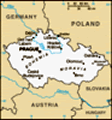Advertisement
Published: September 24th 2012
War? A Battle in 2012? In Prague?
Smoke swirled across the battlefield. Bodies lay, some moving, others on the ground as still as death. Women, camp followers, moved from body to body. For some there was nothing they could do but shake their heads and wipe a tear away. For others they offered drink to sate their thirst and for others they bound wounds.
The battle ebbed back and forth. Cannon roared, muskets spoke, both sending great clouds of smoke into the sky. Men with pikes moved forward to meet advancing groups carrying battle axes and swords.
What is going on here? This is 21st century Prague. Why the battle? Who is fighting? Why is a battle with medieval weapons being waged here?
The Battle of the White Mountain
The Battle of the White Mountain that took place on the 8th of November 1620 was re-enacted at the site of the real battle which happened 392 years ago. The Battle of the White Mountain, little known and seldom mentioned in US textbooks was an early battle in the Thirty Years War. The outcome of the battle, victory by the
Catholic armies, set the stage for the domination of Bohemia and much of Eastern Europe by the Habsburgs for the next three centuries; only ending in November 1918 when the last emperor, Charles I issued a proclamation recognizing Austria's right to determine the future of the state and renouncing any role in state affairs. Two days later, he issued a separate proclamation for Hungary. Charles I did not officially abdicate, but this proclamation is seen as the end of the Habsburg Empire.
The real Battle of the White Mountain was not large or long lasting by the standards of that day and like Gettysburg in the American Civil War came about more by accident than by design. However as far as I can determine there was nothing like Pickett's Charge here.
A small Catholic contingency was sent forth to probe the Bohemian, or Protestant flank. To their surprise the Bohemians retreated. More units were fed into the battle, the result being a Catholic victory in little more than an hour … about the same amount of time it took for the re-enactment to take place. I have read that about 4000 Bohemians were killed
while the Catholic army lost only approximately 700 men. Prague then fell to the Catholic forces. With the fall of Prague, 47 Bohemian noble leaders were tried for insurrection. Twenty-seven were executed in Prague’s Old Town Square. You can see twenty-seven white crosses inlaid in the cobblestone memorializing these men. The day of the execution has been named “the Day of Blood”. The Thirty Years War continued for another 28 years and there was more bloodshed in Bohemia and in Silesia and Moravia.
Why I was there ...
So this is why there both smoke and battle were swirling around in front of me. I, along with several thousand other people, watched the re-enactment. The, dare I say 'pretend' fighting, was not as intent or fierce as it appears in the photos and that was a good thing. Many of the combatants had the appearance of wounds even as they entered the battle. I could not decide if colored candle wax had been applied in some manner to arms, faces and necks or another substance that gave the appearance of blood. Surely they would not drop wax from a burning candle onto their skin. That would, as
they say, smart a fair bit.
If you are in Prague where the battle is re-enacted I recomment you go and watch ... and if you want to cheer for the winning side you will have to cheer for the Catholic army.
The Twenty-Seven White Crosses
The twenty-seven white crosses inlaid in the cobblestones are easy to see. If you are in downtown Prague as a tourist and if you are facing the clock in Old Town Square walk to your right. Turn left at the end of the building and just before yyour eyes inlaid in the cobblestones you will see the crosses. The executions took place in the square as, I am sure, were many others in other times. Politics was a rough 'game' in those days.
Also a Festival
Naturally the day was not filled with just a re-enactment of a historical battle. Outside the roped off battlefield vendor's tents stood offering all those good foods you would expect at a Czech festival; sausages, breads, fried potatoes and other goodies. Do not go thinking you should count your calories or be concerned about fat and
cholesterol. Just go and enjoy yourself ... and, of course, there were Czech beer, mulled wine, coffee and soft drinks.
The vendor's were not limited to food. All kinds of folk craft were available ... and sadly much of it commerically manufactured. But, though not handmade folk craft, there were wooden swords, medieval knights helmets and other toys to fill a militant child's heart with delight.
And a good time was had by all.
Advertisement
Tot: 0.622s; Tpl: 0.013s; cc: 23; qc: 162; dbt: 0.2376s; 1; m:domysql w:travelblog (10.17.0.13); sld: 1;
; mem: 1.4mb













Virginia Fairley
non-member comment
Interesting
Didn't know they did reenactments over there as well. Sounds like you are finding interesting things to see and do once again. Good to hear from you, Virginia